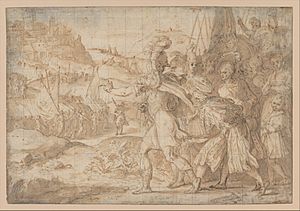Battle of Faesulae (406) facts for kids
Quick facts for kids Battle of Faesulae |
|||||||
|---|---|---|---|---|---|---|---|
| Part of the Roman–Germanic wars | |||||||
 The Siege of Fiesole by the Goths, Friedrich Sustris |
|||||||
|
|||||||
| Belligerents | |||||||
| Western Roman Empire Huns Goths |
Goths Vandals |
||||||
| Commanders and leaders | |||||||
| Stilicho Uldin the Hun Sarus the Goth |
Radagaisus |
||||||
| Strength | |||||||
| 15,000–20,000 | 20,000 | ||||||
| Casualties and losses | |||||||
| Unknown (negligible) | 12,000+ captured | ||||||
The Battle of Faesulae was an important fight in 406 AD. It was part of a big invasion of the Western Roman Empire by a group called the Goths. A powerful Roman general named Flavius Stilicho had already stopped other Gothic groups. But then, a new group of Vandals and Goths, led by Radagaisus, attacked the city of Florence. Stilicho, with help from Uldin the Hun and Sarus the Goth, finally defeated these invaders at a place called Faesulae (which is now Fiesole, Italy). Radagaisus was captured and killed after the battle. Many survivors from his army later joined Alaric.
Why the Battle Happened
In late 405 or early 406, a king named Radagaisus led a huge army into Italy. This army was made up of different groups like the Goths and Alans. They crossed the Alps mountains and marched through northern Italy. They caused a lot of damage to the farms and towns.
Their goal was to attack Florence, a city only about 180 miles north of Rome. The Roman general Stilicho quickly gathered his forces to defend Italy. He got help from different groups. These included a tribe of the Alans, and soldiers from the Goths led by Sarus. He also had help from the Huns led by Uldin.
Stilicho's army had about 20,000 Roman and allied soldiers. Radagaisus's army was much larger. It had about 20,000 warriors. But if you counted their families and other people with them, the total number was between 50,000 and 100,000.
The Battle of Faesulae
While Stilicho was gathering his army, the small group of soldiers defending Florence held out. They fought bravely against Radagaisus's huge army outside their walls. When Stilicho arrived, he managed to send much-needed supplies and more soldiers into the city.
Stilicho did not try to fight Radagaisus's army in a big open battle right away. Instead, he chose a slower but smarter plan. He started by building simple walls and ditches around the barbarian camp. Then, he brought in thousands of local people to help build stronger defenses. These defenses completely surrounded Radagaisus's camp.
The barbarians tried many times to break out of the trap. But the Romans pushed them back every time. Radagaisus's different groups of fighters did not work together well. Their attacks were not organized.
Once the strong walls and ditches were finished, Radagaisus knew his situation was hopeless. His army was stuck deep in enemy land. They had no food, and many people with them needed to eat. On August 23, Radagaisus left his camp to surrender to Stilicho.
Radagaisus had been promised fair treatment. Some even say he was offered an alliance. But Stilicho did not keep his word. He had Radagaisus killed right after he surrendered. This made Stilicho a hero again, seen as the "savior of Italy."
What Happened Next
Stilicho had stopped this big invasion by killing its leader. This saved the Roman Empire for a short time. But he could not completely destroy Radagaisus's huge army. Many of the barbarian survivors did not want to go back north. They did not want to face the Huns again.
Instead, a large part of Radagaisus's army escaped north. These groups included the Suevi, Vandals, Alans, and Burgundians. There were over 100,000 of them. They appeared on the borders of Gaul (modern France). Gaul had fewer defenders because Stilicho had moved soldiers from there to Italy in 401.
At first, the Franks and other Roman allies tried to stop them. But the barbarians soon took over or destroyed much of Gaul. The southwestern part of Gaul was lost to the Western Roman Empire forever. This event was a big step in the decline of the Western Roman Empire.
See also
 In Spanish: Batalla de Fiesole (406) para niños
In Spanish: Batalla de Fiesole (406) para niños

